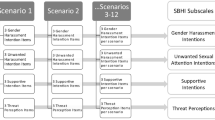Abstract
This study examined the relationship between college students' gender roles and attitudes toward rape. Subjects were 145 male and 374 female college students with a mean age of 20.1 years. The institution has a 12.5% minority population. Subjects received a questionnaire packet containing the Bem Sex Role Inventory (BSRI), an acquaintance or stranger rape scenario, a questionnaire designed to assess attitudes toward the scenario, the short version of the Attitudes Towards Women Scale (AWS), the Rape Myth Acceptance Scale (RMAS), and the Attitudes Toward Rape questionnaire (ATR). It was hypothesized that participants classified as masculine according to the BSRI would believe in more rape myths, hold more pro-rape attitudes, and believe in more traditional gender roles than would those who were classified as feminine, androgynous, or undifferentiated. A gender by gender role interaction on the AWS revealed that feminine and androgynous men were exceptions to the pattern that men had significantly less egalitarian views than women. Responses to the scenario questionnaire suggested that women and men view acquaintance rape differently, and that men may experience more attitude change as a result of a rape awareness workshop than women.
Similar content being viewed by others
References
Barnett, N. J., & Feild, H. S. (1977). Sex differences in university students' attitudes towards rape. Journal of College Student Personnel, 2, 93–96.
Bem, S. (1974). The measurement of psychological androgyny. Journal of Consulting and Clinical Psychology, 42, 155–162.
Bem. S. L. (1981). Bem sex-role inventory: Professional manual. Palo Alto, CA: Consulting Psychologists Press.
Burt, M. B. (1980). Cultural myths and supports for rape. Journal of Personality and Social Psychology, 38, 217–230.
Deitz, S. R., Littman, M., & Bentley, B. J. (1984). Attribution of responsibility for rape: The influence of observer empathy, victim resistance, and victim attractiveness. Sex Roles, 10, 261–280.
Federal Bureau of Investigation. (1981). Uniform crime reports. Washington, DC: U.S. Government Printing Office.
Feild, H. S. (1978). Attitudes toward rape: A comparative analysis of police, rapists, crisis counselors, and citizens. Journal of Personality and Social Psychology, 36, 156–179.
Kanin, E. (1967). Reference groups and sex conduct norm violations. Sociologist Quarterly, 8, 495–504.
Koss, M. P., Dinero, T. E., Seibel, C. A., & Cox, S. L. (1988). Stranger and acquaintance rape: Are there differences in the victim's experience? Psychology of Women Quarterly, 12, 1–24.
Malamuth, N. M. (1981). Rape proclivity among males. Journal of Social Issues, 37, 138–157.
Malamuth, N. M., & Check, J. V. P. (1981). The effects of mass media exposure on acceptance of violence against women: A field experiment. Journal of Research in Personality, 15, 436–446.
Muehlenhard, C. L., & Linton, M. A. (1987). Date rape and sexual aggression in dating situations: Incidence and risk factors. Journal of Counseling Psychology, 34, 186–196.
Muehlenhard, C. L., Friedman, D. E., & Thomas, C. M. (1985). Is date rape justifiable? The effects of dating activity, who initiated, who paid, and men's attitudes toward women. Psychology of Women Quarterly, 9, 297–310.
Quackenbush, R. L. (1989). A comparison of androgynous, masculine sex-typed, and undifferentiated males on dimensions of attitudes toward rape. Journal of Research in Personality, 23, 318–342.
Shotland, R. L., & Goodstein, L. (1983). Just because she doesn't want to doesn't mean that it's rape: An experimentally based causal model of the perception of rape in a dating situation. Social Psychology Quarterly, 46, 220–232.
Spence, J. T., & Helmreich, R. (1972). The attitudes Toward Women Scale: An objective instrument to measure attitudes toward the rights and roles of women in contemporary society. JSAS Catalogue of Selected Documents in Psychology 2, 1–48.
Spence, J. T., Helmreich, R., & Stapp, J. (1973). A short version of the Attitudes Toward Women Scale (AWS). Bulletin of the Psychonomic Society, 2, 219–220.
Tetreault, P. A., & Barnett, M. A. (1987). Reactions to stranger and acquaintance rape. Psychology of Women Quarterly, 11, 353–358.
Warshaw, R. (1988). I never called it rape: The Ms. report on recognizing, fighting, and surviving date and acquaintance rape. New York: Harper & Row.
Author information
Authors and Affiliations
Rights and permissions
About this article
Cite this article
Szymanski, L.A., Devlin, A.S., Chrisler, J.C. et al. Gender role and attitudes toward rape in male and female college students. Sex Roles 29, 37–57 (1993). https://doi.org/10.1007/BF00289995
Issue Date:
DOI: https://doi.org/10.1007/BF00289995




